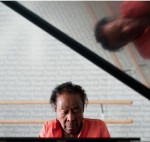Column Name
Title
Subhead
More than five decades since receiving a degree as one of Juilliard’s first African-American graduates, Marjorie Landsmark-DeLewis (Diploma ’48, piano) occupies a special place in the ranks of American dance musicians. Over the course of her distinguished career, she worked with Agnes de Mille as rehearsal pianist for the American Ballet Theater, accompanied classes for dance legends Antony Tudor and David Howard, and served as music director for dance at Sarah Lawrence College. At age 90, she remains active as a composer and performer, and was recently featured as a special guest artist at the International Guild of Musicians in Dance’s 20th anniversary conference in Tucson.
Body
Landsmark-DeLewis was born and raised in Harlem, where she began music lessons at age 5 with her uncle, a classically trained pianist who taught her in the same way he’d been instructed as a youngster in St. Kitts—by rapping her knuckles when she made a mistake. Seven years and a few sore fingers later, she began studying with Edward H. Margetson, a prominent black composer, conductor, and church organist who lived in Washington Heights. Lessons, Landsmark-DeLewis recalled in a recent interview with The Journal, cost 50 cents.
When it came time for college, Juilliard was the obvious choice. Not only did she have the talent and a strongly developed sense of discipline instilled by two demanding teachers, but the School, in its previous Morningside Heights location, was within walking distance of her family’s home. At Juilliard, Landsmark-DeLewis’s instructors included Karl Friedberg, Lonnie Epstein, and Arthur Newstead, with whom she continued to study for several years after completing her degree. As she remembers, there were very few black students enrolled in the School at the time, but “we didn’t stand around and talk with each other—we were so happy being at Juilliard we didn’t want to waste time.”
It wasn’t until the excitement of graduation was over that she asked herself, “Now what am I going to do with this [degree]?” By luck—or divine intervention, if you ask Landsmark-DeLewis—she found the perfect opportunity on Juilliard’s job placement board, where Aubrey Hitchens (an influential dance teacher and one of Anna Pavlova’s last partners) had placed an ad for a pianist to play Bach’s Italian Concerto for rehearsals and performances at Jacob’s Pillow Dance Festival in Becket, Mass. Having just performed the concerto on her graduation recital, Landsmark-DeLewis immediately contacted Hitchens and aced the audition. She went on to become his rehearsal pianist, quickly demonstrating an exceptional sensitivity to dancers’ needs and gaining a vast knowledge of repertoire from the piles of scores he gave her.
Another prominent artist who recognized Landsmark-DeLewis’s talent was the famed choreographer Agnes de Mille. Their association came about when de Mille attended one of Hitchens’s rehearsals and surreptitiously slipped the pianist a note. It read, “You don’t belong here. Call me.” At de Mille’s invitation, Landsmark-DeLewis became a rehearsal pianist for the American Ballet Theater during late-1950s, when the noted ballerina Gemze de Lappe was at the company. Landsmark-DeLewis recalls with some amusement that the room assignment boards at the company would often list the “de Mille, de Lappe, and DeLewis” triumvirate. She also vividly remembers having to sight readLe Corsaire during a rehearsal with Margot Fontayn and Rudolf Nureyev, when another A.B.T. pianist cancelled at the last minute—one of several times in her career, she said, that the score-reading class she’d taken at Juilliard came in handy.
It was also at A.B.T. that Landsmark-DeLewis’s now-legendary ability to improvise first came to light. She was playing a Chopin waltz when the instructor turned to her and asked if she could “do something else” with it. She inverted a phrase and, as she recounted, “suddenly a light bulb went on.” This unleashing of her musical imagination represented a turning point in her artistic development, as the full extent of her extraordinary gift quickly became evident.
Landsmark-DeLewis’s job at A.B.T. took an unwelcome turn, however, when the company scheduled a tour to Atlanta at a time when racial segregation was still in force. Told by the director that she wouldn’t be able to stay in the same hotel with rest of the company, but would instead have to find her own lodging in a black neighborhood, she declined. Her dignity intact, she quickly found a new position at the Harkness Ballet. She segued into higher education as the first pianist hired by the dance division at SUNY Purchase, and was later appointed to the faculty at Sarah Lawrence College.
Looking back on a fulfilling career, Landsmark-DeLewis expressed no regrets, just one pet peeve: she hates it when dancers put their gear down on the piano.
Yet her love for her work remains so strong that she still occasionally wakes up at 3 a.m., she said, and wonders, “What am I going to play for pliés today?”
Correction: September 28, 2010
This article has been amended to reflect the following corrections: An earlier version stated that Landsmark-DeLewis's uncle had been instructed as a youngster in St. Kitts. It was St. Lucia. The article also stated that Edward H. Margetson lived one floor down from the Landsmark-DeLewis family's apartment. He lived in Washington Heights.





